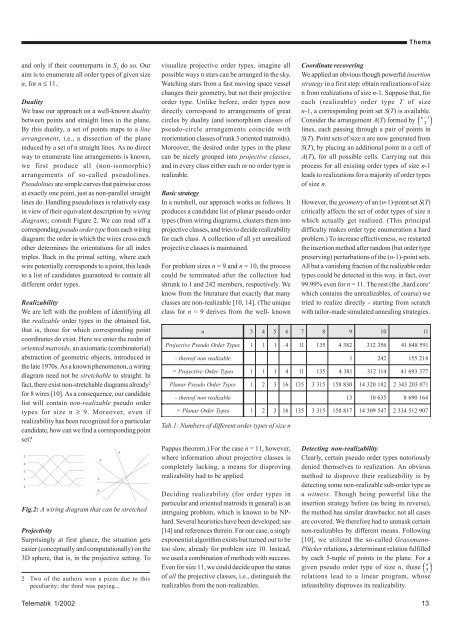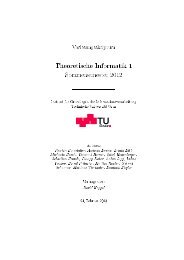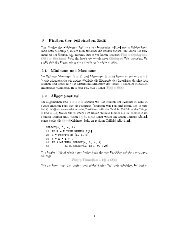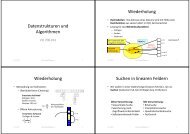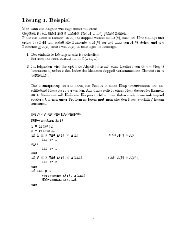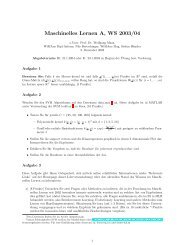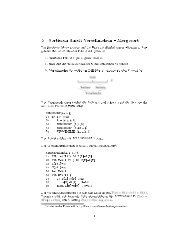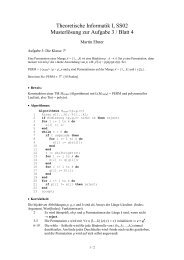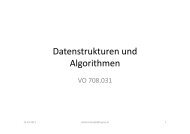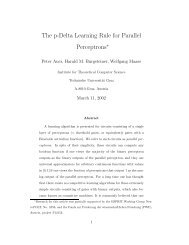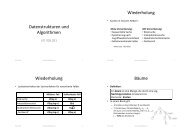Telematik 2/02 - Institut für Grundlagen der Informationsverarbeitung ...
Telematik 2/02 - Institut für Grundlagen der Informationsverarbeitung ...
Telematik 2/02 - Institut für Grundlagen der Informationsverarbeitung ...
You also want an ePaper? Increase the reach of your titles
YUMPU automatically turns print PDFs into web optimized ePapers that Google loves.
and only if their counterparts in S 2 do so. Our<br />
aim is to enumerate all or<strong>der</strong> types of given size<br />
n, for n ≤ 11.<br />
Duality<br />
We base our approach on a well-known duality<br />
between points and straight lines in the plane.<br />
By this duality, a set of points maps to a line<br />
arrangement, i.e., a dissection of the plane<br />
induced by a set of n straight lines. As no direct<br />
way to enumerate line arrangements is known,<br />
we first produce all (non-isomorphic)<br />
arrangements of so-called pseudolines.<br />
Pseudolines are simple curves that pairwise cross<br />
at exactly one point, just as non-parallel straight<br />
lines do. Handling pseudolines is relatively easy<br />
in view of their equivalent description by wiring<br />
diagrams; consult Figure 2. We can read off a<br />
corresponding pseudo or<strong>der</strong> type from each wiring<br />
diagram: the or<strong>der</strong> in which the wires cross each<br />
other determines the orientations for all index<br />
triples. Back in the primal setting, where each<br />
wire potentially corresponds to a point, this leads<br />
to a list of candidates guaranteed to contain all<br />
different or<strong>der</strong> types.<br />
Realizability<br />
We are left with the problem of identifying all<br />
the realizable or<strong>der</strong> types in the obtained list,<br />
that is, those for which corresponding point<br />
coordinates do exist. Here we enter the realm of<br />
oriented matroids, an axiomatic (combinatorial)<br />
abstraction of geometric objects, introduced in<br />
the late 1970s. As a known phenomenon, a wiring<br />
diagram need not be stretchable to straight. In<br />
fact, there exist non-stretchable diagrams already 2<br />
for 8 wires [10]. As a consequence, our candidate<br />
list will contain non-realizable pseudo or<strong>der</strong><br />
types for size n ≥ 9. Moreover, even if<br />
realizability has been recognized for a particular<br />
candidate, how can we find a corresponding point<br />
set?<br />
Fig.2: A wiring diagram that can be stretched<br />
Projectivity<br />
Surprisingly at first glance, the situation gets<br />
easier (conceptually and computationally) on the<br />
3D sphere, that is, in the projective setting. To<br />
2 Two of the authors won a pizza due to this<br />
peculiarity; the third was paying...<br />
<strong>Telematik</strong> 1/20<strong>02</strong><br />
visualize projective or<strong>der</strong> types, imagine all<br />
possible ways n stars can be arranged in the sky.<br />
Watching stars from a fast moving space vessel<br />
changes their geometry, but not their projective<br />
or<strong>der</strong> type. Unlike before, or<strong>der</strong> types now<br />
directly correspond to arrangements of great<br />
circles by duality (and isomorphism classes of<br />
pseudo-circle arrangements coincide with<br />
reorientation classes of rank 3 oriented matroids).<br />
Moreover, the desired or<strong>der</strong> types in the plane<br />
can be nicely grouped into projective classes,<br />
and in every class either each or no or<strong>der</strong> type is<br />
realizable.<br />
Basic strategy<br />
In a nutshell, our approach works as follows. It<br />
produces a candidate list of planar pseudo or<strong>der</strong><br />
types (from wiring diagrams), clusters them into<br />
projective classes, and tries to decide realizability<br />
for each class. A collection of all yet unrealized<br />
projective classes is maintained.<br />
For problem sizes n = 9 and n = 10, the process<br />
could be terminated after the collection had<br />
shrunk to 1 and 242 members, respectively. We<br />
know from the literature that exactly that many<br />
classes are non-realizable [10, 14]. (The unique<br />
class for n = 9 <strong>der</strong>ives from the well- known<br />
Tab.1: Numbers of different or<strong>der</strong> types of size n<br />
Pappus theorem.) For the case n = 11, however,<br />
where information about projective classes is<br />
completely lacking, a means for disproving<br />
realizability had to be applied.<br />
Deciding realizability (for or<strong>der</strong> types in<br />
particular and oriented matroids in general) is an<br />
intriguing problem, which is known to be NPhard.<br />
Several heuristics have been developed; see<br />
[14] and references therein. For our case, a singly<br />
exponential algorithm exists but turned out to be<br />
too slow, already for problem size 10. Instead,<br />
we used a combination of methods with success.<br />
Even for size 11, we could decide upon the status<br />
of all the projective classes, i.e., distinguish the<br />
realizables from the non-realizables.<br />
Coordinate recovering<br />
We applied an obvious though powerful insertion<br />
strategy in a first step: obtain realizations of size<br />
n from realizations of size n-1. Suppose that, for<br />
each (realizable) or<strong>der</strong> type T of size<br />
n-1, a corresponding point set S(T) is available.<br />
Consi<strong>der</strong> the arrangement A(T) formed by<br />
Thema<br />
⎛ n − 1⎞<br />
⎜ ⎟<br />
⎝ 2 ⎠<br />
lines, each passing through a pair of points in<br />
S(T). Point sets of size n are now generated from<br />
S(T), by placing an additional point in a cell of<br />
A(T), for all possible cells. Carrying out this<br />
process for all existing or<strong>der</strong> types of size n-1<br />
leads to realizations for a majority of or<strong>der</strong> types<br />
of size n.<br />
However, the geometry of an (n-1)-point set S(T)<br />
critically affects the set of or<strong>der</strong> types of size n<br />
which actually get realized. (This principal<br />
difficulty makes or<strong>der</strong> type enumeration a hard<br />
problem.) To increase effectiveness, we restarted<br />
the insertion method after random (but or<strong>der</strong> type<br />
preserving) perturbations of the (n-1)-point sets.<br />
All but a vanishing fraction of the realizable or<strong>der</strong><br />
types could be detected in this way, in fact, over<br />
99.99% even for n = 11. The rest (the ‚hard core‘<br />
which contains the unrealizables, of course) we<br />
tried to realize directly - starting from scratch<br />
with tailor-made simulated annealing strategies.<br />
n 3 4 5 6 7 8 9 10 11<br />
Projectiv e Pseudo<br />
Or<strong>der</strong><br />
Types<br />
1 1 1 4 11 135 4 382<br />
312 356<br />
41<br />
848<br />
591<br />
- thereof<br />
non<br />
realizable<br />
1 242 155<br />
214<br />
= Projectiv<br />
e Or<strong>der</strong><br />
Types<br />
1 1 1 4 11 135 4 381<br />
312 114<br />
41<br />
693<br />
377<br />
Planar Pseudo<br />
Or<strong>der</strong><br />
Types<br />
1 2 3 16 135 3 315<br />
158830 14320182 2 343<br />
203<br />
071<br />
- thereof<br />
non<br />
realizable<br />
1310635 8 690<br />
164<br />
= Planar<br />
Or<strong>der</strong><br />
Types<br />
1 2 3 16 135 3 315<br />
158817 14309547 2 334<br />
512<br />
907<br />
Detecting non-realizability<br />
Clearly, certain pseudo or<strong>der</strong> types notoriously<br />
denied themselves to realization. An obvious<br />
method to disprove their realizability is by<br />
detecting some non-realizable sub-or<strong>der</strong> type as<br />
a witness. Though being powerful like the<br />
insertion strategy before (as being its reverse),<br />
the method has similar drawbacks: not all cases<br />
are covered. We therefore had to unmask certain<br />
non-realizables by different means. Following<br />
[10], we utilized the so-called Grassmann-<br />
Plücker relations, a determinant relation fulfilled<br />
by each 5-tuple of points in the plane. For a<br />
⎛ n ⎞<br />
given pseudo or<strong>der</strong> type of size n, these ⎜ . ⎟<br />
⎝ 5 ⎠<br />
relations lead to a linear program, whose<br />
infeasibility disproves its realizability.<br />
13


